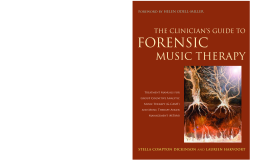
BOOK
The Clinician's Guide to Forensic Music Therapy
Stella Compton-Dickinson | Laurien Hakvoort | Helen Odell-Miller
(2017)
Additional Information
Book Details
Abstract
The Clinician's Guide to Forensic Music Therapy provides information and advice on how to effectively and safely deliver two context-specific, systematic approaches in forensic music therapy.
The two clinically tested treatment manuals have been specifically designed for use by music therapists and other clinicians working in prisons and secure hospital settings. They provide in-depth practical guidance for a variety of contexts and specific attention is given to risk assessment, responsivity to treatment and recovery. The book also includes advice on clinical evaluation, taking the complexities of diagnosis and patient needs into consideration.
As the very first of its kind, and written by two leading practitioners of forensic music therapy, this book is essential reading for any music therapist and student of music therapy. It will also be of interest to other clinicians working in correctional or secure psychiatric settings and includes a chapter for them on how to use music effectively.
Dr Stella Compton-Dickinson is a London-based Health and Care Profession council registered music therapist, accredited supervisor, professional oboist and lecturer, UK Council for Psychotherapy registered therapist and supervisor. She has her own private practice and twenty years' experience in the National Health Service as a Clinician, Head of Arts Therapies and Clinical Research Lead.
Dr Laurien Hakvoort is a Dutch senior registered music therapist and Neurologic Music Therapy fellow. She is a lecturer in music therapy of ArtEZ school of music and worked for 17 years in forensic psychiatry.
Creating treatment manuals in music therapy is of great importance, and this book provide two manuals for music therapy in Forensic Music Therapy. Even though a music therapist can't acquire therapeutic skills only by reading, this book contains detailed descriptions of how treatment can be done, besides also containing a huge appendix sections with usable tools.
Niels Hannibal, Associate Professor, Music Therapy, Aalborg University
Students, clinicians, and researchers will find this text progressive and applicable. The thoroughly tested treatment manuals for this traditionally underserved and marginalized clinical population constitute welcome additions to our profession. I offer a sincere thanks to these distinguished scholars for their remarkable and comprehensive contribution to the music therapy literature.
Michael J. Silverman, PhD, MT-BC; Director of Music Therapy, University of Minnesota, USA
From cover to cover, this book holds a wealth of helpful information regarding key aspects of music therapy work within forensic psychiatry underpinned by years of experience working within these environments, a vast amount of research and a solid theoretical understanding of the sensitive and complex psychological and organisational processes in these settings.
Nicole Wakeling, Music Therapist, Langdon Hospital, Regional Secure Unit, Dawlish, Devon
Learning and Integration, Issue 49 Winter 2017
Table of Contents
| Section Title | Page | Action | Price |
|---|---|---|---|
| The Clinician's Guide to Forensic Music Therapy by Stella Compton Dickinson and Laurien Hakvoort | 3 | ||
| Foreword by Helen Odell-Miller | 9 | ||
| Acknowledgements | 11 | ||
| Preface | 12 | ||
| Chapter 1. The Rationale for a Music Therapy Treatment Manual for Men and Women in Secure Forensic Treatment | 13 | ||
| Chapter 2. Cognitive Analytic Music Therapy | 24 | ||
| Appendix 2a - The Psychotherapy File | 50 | ||
| Appendix 2b - Target Problem Procedure Sheet | 60 | ||
| Appendix 2c - Helpful Aspects of Therapy (HAT) Questionnaire | 62 | ||
| Appendix 2d - The States Description Procedure (SDP) | 63 | ||
| Appendix 2e - The Personality Structure Questionnaire (PSQ) | 69 | ||
| Appendix 2f - Group Diagram | 71 | ||
| Appendix 2g - The Art and Music Therapy Patient Satisfaction Questionnaire (AMT-PSQ) | 72 | ||
| Appendix 2h - Patient Feedback Questionnaire | 74 | ||
| Chapter 3. Music Therapy Anger Management | 77 | ||
| Appendix 3a - Music Therapy Anger Management Handout | 115 | ||
| Appendix 3b - Music Therapy Anger Management Questionnaire | 116 | ||
| Appendix 3c - Musical Polarities | 117 | ||
| Appendix 3d - Stress Gauge Sheet | 118 | ||
| Appendix 3e - Large Stress Gauge Sheet | 120 | ||
| Chapter 4. The G-CAMT and MTAM Manualised Music Therapy Approaches in Different Forensic Psychiatric Settings | 121 | ||
| Chapter 5. Guidance and Practical Worksheets for Music Therapists (Specialist Use) | 133 | ||
| Appendix 5a - Multi-Disciplinary Integrated Care Pathway Programme for which G-CAMT Was Designed | 145 | ||
| Chapter 6. Evaluating Clinical Practice | 149 | ||
| Appendix 6a - Semi-Structured Interview Schedule | 163 | ||
| Appendix 6b - Chart of Interpersonal Reactions in Closed Living Environments (CIRCLE) | 168 | ||
| Appendix 6c - FP40 Music Therapy Coping Lists | 171 | ||
| Appendix 6d - Code Book FP40 Music Therapy Coping Lists | 175 | ||
| Chapter 7. Guidance for Clinicians in the Use of Music | 180 | ||
| Epilogue | 191 | ||
| Postscript | 193 | ||
| References | 194 | ||
| Index | 202 |
